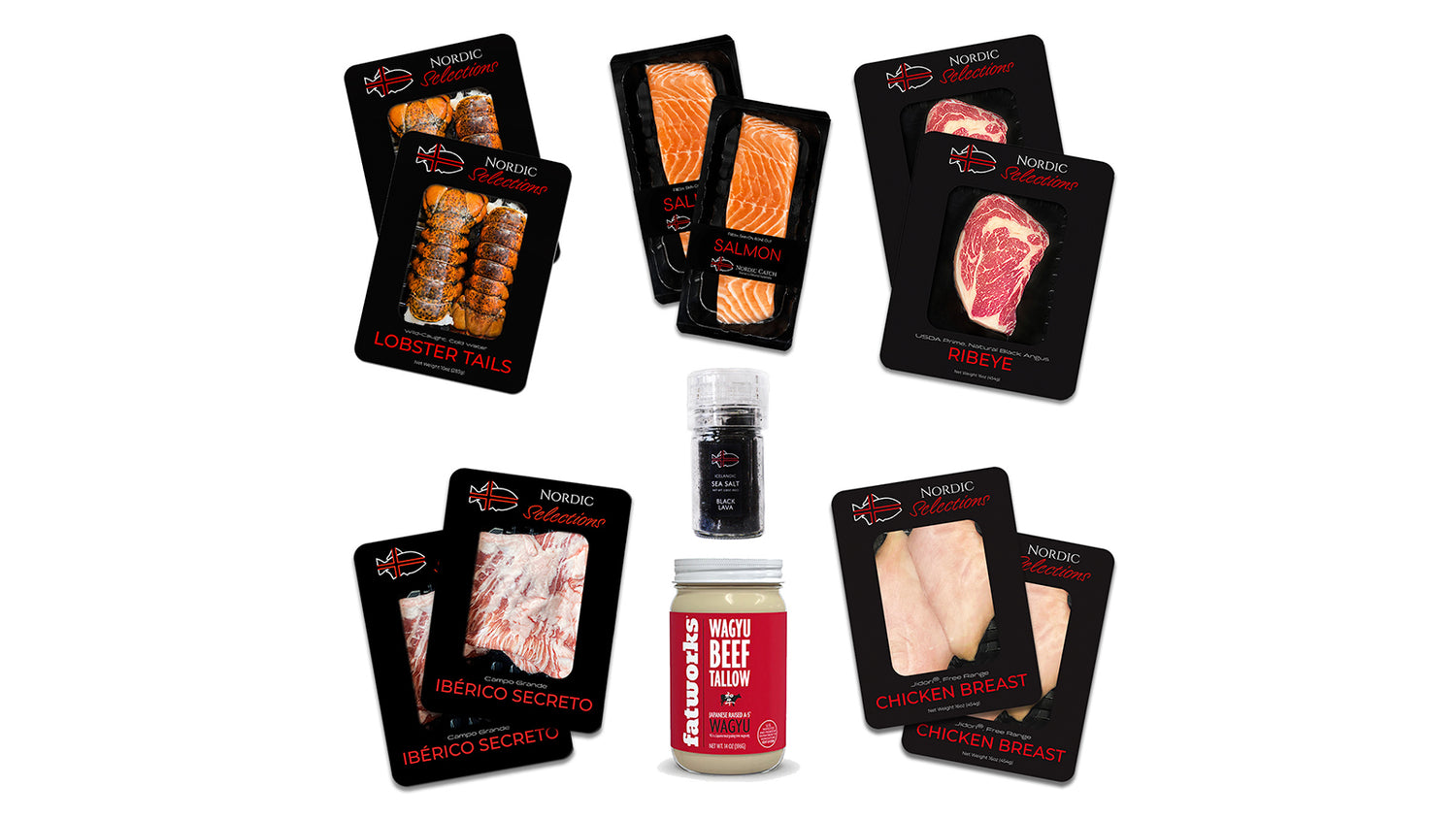
Wild-Caught vs. Farm-Raised Fish: Similarities & Differences
Consumers often ask us to explain the differences between wild-caught seafood and farm-raised fish. On the surface, the answer is straightforward: Wild-caught seafood hails from natural habitats, like oceans, lakes, or rivers, while farmed seafood grows in controlled environments.
But if you want to make the most health-conscious choice possible, there's so much more to it. Understanding these categories' benefits and potential drawbacks will help you decide your dietary needs. With that in mind, let's break down the differences.
Diet, Appearance, & Flavor
The diet of farm-raised fish, which includes cornmeal, wheat, and animal by-products, affects their taste, size, and color. These fish are often thicker and less colorful than wild fish, which have a more complex flavor and vibrant appearance due to a natural diet. Many people find this difference in diet contributes to a superior taste and firmer texture in wild-caught fish over farm-raised fish.
Nutritional Differences
The nutritional quality of seafood largely depends on the fish's diet. Wild fish tend to have lower saturated fat due to their natural diet. At the same time, farm-raised varieties can be higher in omega-3 fatty acids, thanks to their fortified feed. However, farm-raised fish may also have higher omega-6 fatty acids because their diets are rich in processed foods and vegetable oils.
Contaminants & Pollutants
Both wild-caught and farm-raised fish can contain mercury and dioxins. Farm-raised fish may be more prone to contamination due to farming conditions. Still, wild-caught fish can also carry these contaminants from polluted waters. This is a significant reason why sourcing your seafood responsibly is so important to minimize your health risks.
Sustainability Considerations
Sustainability factors can vary widely depending on the species and location of the fishery. Some farmed fish can be more sustainable if the farmers raise them under strict regulations. Still, wild-caught fish generally have a lower environmental impact if they're sustainably harvested. If you care about the health of our oceans, it's crucial to support sustainable fishing practices, such as:
- Catch limits: Setting quotas on how much of each species farmers can catch to prevent overfishing.
- Selective gear use: Using gear targeting specific species and sizes reduces bycatch and minimizes habitat damage.
- Seasonal closures: Implementing fishing bans during breeding or spawning seasons to allow fish populations to replenish.
- Marine protected areas (MPAs): Designating regions where fishing is restricted or prohibited to preserve marine ecosystems.
- Community-based management: Involving local communities in decision-making to manage fishery resources sustainably.
Cost Factors
Wild-caught fish are generally more expensive than farm-raised options due to the labor-intensive methods of catching them and because they're usually of higher quality. However, frozen seafood or canned wild-caught fish can be more affordable, offering an alternative that keeps quality high if you're on a budget but still prefer wild-caught fish.
Geographic Origin
Seafood quality varies significantly depending on its origin. For example, U.S. and European fish farms are often subject to stricter regulations, leading to potentially safer products. In contrast, seafood from some Asian countries may have higher levels of antibiotics and contaminants due to less stringent rules. When choosing seafood, you must consider where it comes from to ensure you get a high-quality product.
Cooking & Texture Differences
Wild fish are firmer and require careful cooking to avoid becoming inflexible. In contrast, farm-raised fish have a softer, buttery texture, making them more forgiving in the kitchen. The higher fat content in farm-raised fish allows for longer cooking, making them suitable for slow roasting or baking. In contrast, wild-caught fish are best with more straightforward, faster preparations like grilling or pan-searing.
Transparency & Labeling
Understanding seafood labels, including the Country of Origin Labeling (COOL), is crucial when you want to make informed decisions about the source and quality of your seafood. Look for certifications like the Marine Stewardship Council (MSC) label to ensure the fish was sourced sustainably. Labels also usually include the geographic source of the fish, which can tell you something about its origins.
Alaskan salmon vs. Atlantic salmon: Pacific or Alaskan salmon is usually wild-caught, and Atlantic salmon is often farm-raised.
If you're wondering if farm-raised salmon is bad for you, understanding these labels can help you choose responsibly sourced options that fit your preferences and health needs.
Consumer Preferences & Perceptions
Many consumers prefer wild-caught fish for its flavor and perceived health benefits. Still, farm-raised fish offers a viable alternative for those prioritizing cost, availability, or milder flavor profiles. Both options have their place in the market, depending on your preferences and values.
Health Risks & Benefits
Farm-raised fish might have fewer contaminants due to controlled environments. Still, wild-caught fish generally provide more beneficial nutrients like omega-3 fatty acids. However, both types of fish can be part of a healthy diet, depending on their source and handling. The key is to consume seafood that is responsibly sourced and properly managed to minimize your health risks and enjoy the benefits, such as:
- Omega-3 fatty acids: Fish, especially fatty fish like salmon and mackerel, are high in omega-3s, which support heart health and brain function and reduce inflammation.
- High-quality protein: Fish is a lean source of complete protein essential for muscle repair and overall body function.
- Vitamins & minerals: Fish is a good source of vitamins D and B2 (riboflavin), as well as minerals like calcium, phosphorus, iron, zinc, iodine, magnesium, and potassium.
- Heart health: Regular fish consumption is associated with a lower risk of heart disease, thanks to its healthy fats and nutrient profile.
- Brain health: Omega-3 fatty acids in fish contribute to cognitive function and may reduce the risk of Alzheimer's and dementia.
- Low-saturated fat: Fish is lower in saturated fat than red meat, making it a healthier protein option.
Frequently Asked Questions
What are the nutritional differences between wild-caught and farm-raised fish?
Due to their natural diet, wild-caught fish like salmon often have higher omega-3 content and varied flavors. However, they may contain mercury. Farm-raised fish tend to have a milder, buttery flavor and higher omega-6 content, but they may contain synthetic compounds.
How do wild-caught and farm-raised fish impact the environment?
Both have ecological implications. Overfishing can deplete wild fish populations and disrupt marine ecosystems. In contrast, fish farming can lead to water pollution and habitat destruction. Responsible sourcing is crucial for sustainability.
Does the taste of fish vary depending on whether it's wild or farm-raised?
Yes, the taste usually differs. Wild-caught fish may have a diverse, nuanced flavor due to their varied diet, while farm-raised fish often have a softer, buttery taste due to their higher fat content.
How does the method of fish farming affect the fish and the environment?
Farming methods greatly influence the health of fish and the environment. Outdoor systems, like open net pens, can pollute water bodies, but if well-managed, they operate sustainably. Indoor recirculating systems control waste better but require more energy. Sustainable farming is essential for the long-term health of fish species and the oceans.
What is the importance of stringent regulations in fish farming and capturing wild fish?
Stringent regulations ensure sustainability by preventing overfishing, promoting responsible farming practices, limiting environmental damage, and preserving fish populations for future generations.
What social and ethical considerations are there in the seafood industry?
The seafood industry often involves harsh working conditions. Overfishing can impact local economies that rely on fishing. Therefore, ethical considerations when buying seafood include ensuring fair trade and responsible resource management.

